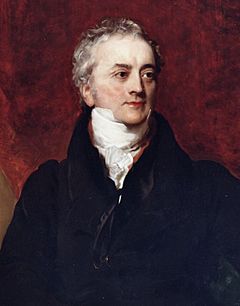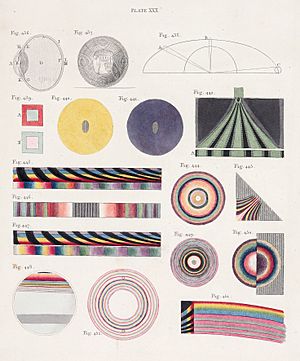Thomas Young (scientist) facts for kids
Quick facts for kids
Thomas Young
|
|
|---|---|

Portrait by Henry Perronet Briggs, 1822
|
|
| Born | 13 June 1773 Milverton, Somerset, England
|
| Died | 10 May 1829 (aged 55) London, England
|
| Alma mater | University of Edinburgh Medical School University of Göttingen Emmanuel College, Cambridge |
| Known for | Wave theory of light Double-slit experiment Astigmatism Young–Dupré equation Young–Helmholtz theory Young–Laplace equation Young temperament Young's Modulus Young's rule |
| Scientific career | |
| Fields | Physics Physiology Egyptology |
| Influenced | William Herschel, James Clerk Maxwell, Albert Einstein, Augustin-Jean Fresnel, Jean-François Champollion |
| Signature | |
Thomas Young (June 13, 1773 – May 10, 1829) was a brilliant British scientist. He was a polymath, meaning he was an expert in many different subjects. Young made important discoveries in areas like how we see, how light works, how materials stretch, and even ancient Egyptian history.
One of his most famous achievements was helping to figure out the meaning of Egyptian hieroglyphs. He played a key role in understanding the Rosetta Stone, which was a big step in learning about ancient Egypt.
People have called Thomas Young "The Last Man Who Knew Everything" because he knew so much. His ideas influenced many other famous scientists, including Albert Einstein. Young also helped prove that light travels in waves, like ripples in water, which was a new idea at the time.
Contents
About Thomas Young's Life
Thomas Young was born in 1773 in Milverton, England. He was the oldest of ten children in a Quaker family. Even when he was young, he was incredibly smart. By age 14, he had already learned many languages, including Greek, Latin, French, Arabic, and Persian!
Young started studying medicine in London in 1792. He continued his studies in Edinburgh, Scotland, and then in Göttingen, Germany, where he earned his medical degree. In 1797, he went to Cambridge University. Around this time, he inherited money, which meant he didn't have to worry about finances. He then started his own medical practice in London. To protect his reputation as a doctor, he often published his scientific articles without his name on them.
In 1801, Young became a professor of natural philosophy (which is what physics was called back then) at the Royal Institution. He gave 91 lectures in just two years! He also became a foreign secretary for the Royal Society, a famous group of scientists. However, he left his teaching job in 1803 because he wanted to focus more on his medical work. His lectures were later published in a book in 1807.
Young continued to work in medicine and science throughout his life. He became a doctor at St George's Hospital in 1811. He also helped with important projects, like figuring out how to safely use gas lighting in London and measuring the exact length of a seconds pendulum (a pendulum that swings back and forth in exactly two seconds).
Thomas Young was recognized by many important scientific groups around the world. He was elected a member of the American Academy of Arts and Sciences in 1822. He also joined the French Academy of Sciences and the Royal Institute of the Netherlands.
In 1804, Thomas Young married Eliza Maxwell. They did not have any children.
Young passed away in London on May 10, 1829, when he was 55 years old. He had been ill for some time. He was buried in Farnborough, England. There is a special marble tablet in his memory at Westminster Abbey, a very famous church in London.
His friends and colleagues thought very highly of him. They said he was always ready to answer difficult science questions. Even though he was very knowledgeable, some people found it hard to understand him sometimes because his way of explaining things was unique.
Young's Beliefs
We don't know much about Thomas Young's personal religious beliefs. He grew up in a Quaker family, and his wife said that his Quaker background influenced his religious practices. Before he got married, he joined the Church of England.
Young believed in using his talents wisely. He once said that he would continue to use his skills diligently in his medical profession, which was his main goal. Before he died, he took part in religious ceremonies, showing his faith. He had studied the Bible deeply, and its teachings were important to him from a young age.
Amazing Discoveries and Research
Thomas Young made many important contributions to science. Here are some of his key discoveries:
How Light Travels: The Wave Theory
Young believed that light travels in waves, like ripples in a pond. This was a big idea because for a long time, people thought light was made of tiny particles, a theory supported by Isaac Newton. Young's work helped prove that light acts like a wave.
He showed this with a famous experiment called the double-slit experiment. He used a card with a tiny opening and observed how light passed through it. He noticed colored fringes (bands) in the shadow and around the card. When he blocked one side of the opening, the fringes disappeared. This showed that light waves interfered with each other, creating the patterns, just like water waves do.
Young explained his experiment in 1803, saying it could be done easily by anyone on a sunny day. His work was later supported and expanded by another scientist named Augustin-Jean Fresnel.
How Materials Stretch: Young's Modulus
Young also studied how materials stretch and bend. He described a property called Young's modulus, which helps engineers understand how strong and stiff a material is. This measurement tells you how much a material will change its length when a certain amount of force is applied to it.
Even though Young described it in 1807, the idea was actually used in experiments by another scientist, Giordano Riccati, 25 years earlier. The basic concept can even be traced back to Leonhard Euler in 1727.
Young's modulus was revolutionary for engineering. Before this, engineers had to test every new part to see how it would deform under a load. But Young's modulus depends only on the material itself, not its shape. This meant engineers could predict how a material would behave without needing to test every single design.
Young's explanation of his modulus was a bit complicated. When he sent it to the British Navy, they told him it was "too learned" and they didn't understand it!
How We See: Vision and Color Theory
Thomas Young is also known as a founder of the study of how our eyes work. In 1793, he explained how our eyes adjust to see things at different distances. He discovered that the crystalline lens inside our eye changes its shape.
In 1801, he was the first to describe astigmatism, a common vision problem where the eye's lens or cornea is not perfectly curved, causing blurry vision.
He also proposed a theory about how we see colors. He suggested that our eyes have three different types of nerve fibers (now known as cone cells) that are sensitive to different colors of light. This idea, later developed by Hermann von Helmholtz, is called the Young–Helmholtz theory. It matches what we know today about how our eyes detect red, green, and blue light to create all the colors we see.
Liquids and Surfaces: Young–Laplace Equation
In 1804, Young developed ideas about surface tension, which is the force that holds the surface of a liquid together (like why water forms drops). He also noticed that the angle where a liquid meets a solid surface stays the same.
Later, a French scientist named Pierre-Simon Laplace added to Young's work. In 1830, a German mathematician named Carl Friedrich Gauss combined their ideas to create the Young–Laplace equation. This formula helps describe the pressure difference across the surface between two liquids, like the curve you see at the top of water in a narrow tube.
Young was also the first to use the word "energy" in the way we use it today in science.
Medicine and Health
Young made important contributions to the study of blood flow. He developed a formula for the speed of a pulse. He also wrote medical books, including one about different diseases.
He even created a simple rule for doctors to figure out the right amount of medicine for a child. This is called Young's Rule. It says you take the child's age, divide it by the child's age plus 12, and then multiply that by the adult dose.
Languages and Words
Young was a language genius! In 1796, he suggested a universal phonetic alphabet, which is a system for writing down sounds.
In an article for the Encyclopædia Britannica, Young compared the grammar and words of 400 different languages. In 1813, he introduced the term "Indo-European languages" to describe a large family of languages that are related to each other.
Unlocking Ancient Egypt: Hieroglyphs
One of Thomas Young's most exciting achievements was his work on understanding ancient Egyptian writing systems. He started working on this in 1813, when other researchers were also trying to crack the code.
He began by using an alphabet of 29 letters for the Egyptian demotic script (a simpler form of Egyptian writing) that another scholar had created. Young was the first to fully translate the "enchorial" (demotic) text on the Rosetta Stone by 1814. He then studied the hieroglyphic alphabet.
There was a friendly rivalry between Young and Jean-François Champollion, a French scholar, as they both worked on deciphering hieroglyphs. They cooperated briefly at first, but later kept their discoveries secret from each other for many years.
Some of Young's findings appeared in his article "Egypt" for the 1818 edition of the Encyclopædia Britannica.
When Champollion finally published his full translation of the hieroglyphs and explained the grammar in 1822, Young praised his work. However, a year later, Young published his own book to make sure his contributions were recognized as a basis for Champollion's system.
Young had correctly figured out the sound of six hieroglyphic signs. He admitted that Champollion had an advantage because he knew more about ancient languages like Coptic, which was very helpful for understanding Egyptian.
Many experts believe that Young's most important contribution to Egyptology was his work on the demotic script. He made the first big breakthroughs in this area and correctly identified that demotic writing used both picture signs and sound signs.
Later, Young felt that Champollion didn't give him enough credit for his work. This led to some arguments, especially because of political tensions between Britain and France at the time. The British tended to support Young, while the French supported Champollion. Champollion did acknowledge some of Young's help, but not a lot.
Music and Tuning
Thomas Young also developed a way of tuning musical instruments called Young temperament. This method helps musicians make sure their instruments sound good together.
Thomas Young's Lasting Impact
Many scientists and scholars after Young have praised his work, even if they only knew him for his discoveries in their specific fields. John Herschel, a scientist who lived at the same time as Young, called him a "truly original genius." Albert Einstein also praised him in 1931.
The Thomas Young Centre in London, which is a group of researchers studying materials, is named after him. Also, a place in eastern Greenland called Young Sound was named in his honor by a explorer named William Scoresby.
Selected Writings
- A Course of Lectures on Natural Philosophy and the Mechanical Arts (1807)
- Miscellaneous Works of the Late Thomas Young, M.D., F.R.S. (1855, 3 volumes)
Images for kids
See also
 In Spanish: Thomas Young para niños
In Spanish: Thomas Young para niños
- Coandă effect
- Color space
- History of energy
- List of Egyptologists
- Refractive index
- Ultrahydrophobicity






